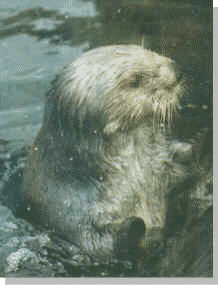
By 1929, relentless hunting and trapping had wholly extirpated this marine mammal from its Canadian range. The largest member of the mustelid, or weasel family, reaches 40 kg and a length of 2 m. It is the only marine mammal to be insulated by a dense coat of soft, fine yet luxuriant fur, not thick blubber. This insulation is crucial as the historic range was along the arc from Japan to California, much of which is temperate to sub-arctic. To maintain body temperature, the sea otter feeds heavily on sea urchins, mussels, crabs and clams. Extirpation of the otter led to a proliferation of sea urchins of the genus _Strongylocentrotus_ which then decimated the extensive Pacific kelp forests. Thus, the sea otter and the urchins are keystone species in kelp forest ecosystems. In 1969, 1970 and 1972, groups of Alaskan sea otters were introduced to the northwest coast of Vancouver Island. These populations have been growing at roughly 12 per cent per year since, with a corresponding increase in kelp bed cover.
 GENERAL DESCRIPTION:
GENERAL DESCRIPTION: Sea otters are members of the weasel or mustelid family. Like other members of this family, they have very thick fur. In fact, at 850,000 to a million hairs per square inch, they have the thickest fur of any mammal. Their fur actually consists of two layers, an undercoat and longer guard hairs. This system traps a layer of air next to their skin so their skin normally never gets wet. Sea otters are usually dark brown, often with lighter guard hairs. Sea otters are the smallest marine mammal. Adult females weigh 50-60 lbs; males reach up to 90 lbs. Alaskan sea otters are bigger and males can weigh up to 100 lbs.
RANGE/HABITAT:
Sea otters once ranged from Mexico to Alaska and even to Japan. Currently, the California population numbers around 2,300 and is found from Santa Cruz to Morro Bay. There is a much larger population in Alaska, and sea otters also are still found in Russia. Sea otters inhabit shallow areas and prefer places with kelp. In fact, resting sea otters will sometimes anchor themselves in one place by wrapping strands of kelp around them.
NOTES:
Gestation is four to five months. Pups can be born any time of year, but most are born in February. The fur of pups traps so much air that they actually cannot dive underwater. When mothers leave the pups to hunt, pups bob on the surface of the ocean like a cork. Mothers spend much time grooming pups and often carry them on their chests. Sea otters are the only tool-using marine mammal. They eat animals with shells, like clams and abalone, and use a stone to break open the shells. Adult sea otters can eat up to 25% of their body weight in one day! Sea otters in California are an endangered species, due to past over-hunting for their beautiful fur. Although sea otters now are protected, they remain vulnerable, especially to oil spills. Unlike other marine mammals, sea otters do not have a blubber layer. Therefore, they rely on their fur to keep warm. If their fur is oiled, it loses its insulating qualities and the sea otters soon chill. Otters are also affected by the oil fumes or poisoned by eating food exposed to oil. Most sea otters quickly die in an oil spill, for instance, several thousand sea otters died in the 1989 Exxon oil spill in Valdez, Alaska.
visits